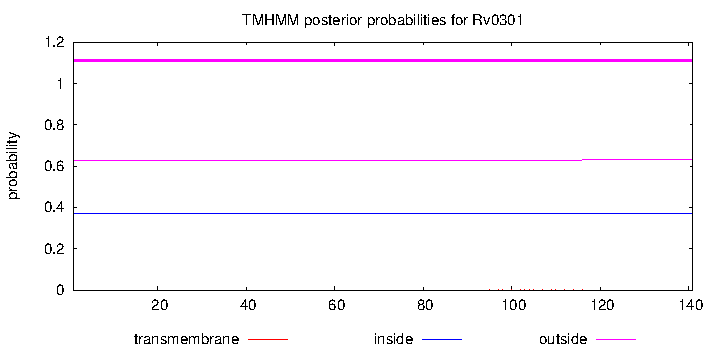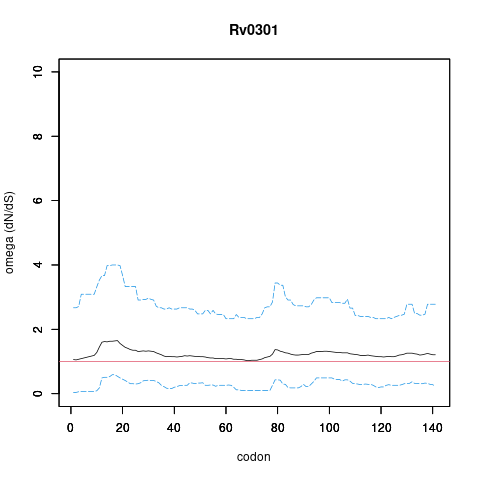| Property | Value | Creator | Evidence | PMID | Comment |
| Interaction | Regulatory Rv0300 | sourish10 | IEP | | Co-expression (Functional linkage)
authors,VL. Arcus,PB. Rainey,SJ. Turner The PIN-domain toxin-antitoxin array in mycobacteria. Trends Microbiol. 2005 |
| Citation | Prokaryotic toxin-antitoxin stress response loci. authors,K. Gerdes,SK. Christensen,A. Lbner-Olesen Nat. Rev. Microbiol. 2005 | sourish10 | IEP | 15864262 | Co-expression (Functional linkage) |
| Interaction | Regulatory Rv0300 | sourish10 | IEP | | Co-expression (Functional linkage)
authors,K. Gerdes,SK. Christensen,A. Lbner-Olesen Prokaryotic toxin-antitoxin stress response loci. Nat. Rev. Microbiol. 2005 |
| Interaction | Regulatory Rv0300 | sourish10 | IEP | | Co-expression (Functional linkage)
authors,K. Gerdes,SK. Christensen,A. Lbner-Olesen Prokaryotic toxin-antitoxin stress response loci. Nat. Rev. Microbiol. 2005 |
| Citation | Comprehensive functional analysis of Mycobacterium tuberculosis toxin-antitoxin systems: implications for pathogenesis, stress responses, and evolution. authors,HR. Ramage,LE. Connolly,JS. Cox PLoS Genet. 2009 | ahal4789 | IEP | 20011113 | Co-expression (Functional linkage) |
| Interaction | Regulatory Rv0300 | ahal4789 | IEP | | Co-expression (Functional linkage)
authors,HR. Ramage,LE. Connolly,JS. Cox Comprehensive functional analysis of Mycobacterium tuberculosis toxin-antitoxin systems: implications for pathogenesis, stress responses, and evolution. PLoS Genet. 2009 |
| Citation | The PIN-domain toxin-antitoxin array in mycobacteria. authors,VL. Arcus,PB. Rainey,SJ. Turner Trends Microbiol. 2005 | ahal4789 | IEP | 15993073 | Co-expression (Functional linkage) |
| Interaction | Regulatory Rv0300 | ahal4789 | IEP | | Co-expression (Functional linkage)
authors,VL. Arcus,PB. Rainey,SJ. Turner The PIN-domain toxin-antitoxin array in mycobacteria. Trends Microbiol. 2005 |
| Citation | Prokaryotic toxin-antitoxin stress response loci. authors,K. Gerdes,SK. Christensen,A. Lbner-Olesen Nat. Rev. Microbiol. 2005 | ahal4789 | IEP | 15864262 | Co-expression (Functional linkage) |
| Interaction | Regulatory Rv0300 | ahal4789 | IEP | | Co-expression (Functional linkage)
authors,K. Gerdes,SK. Christensen,A. Lbner-Olesen Prokaryotic toxin-antitoxin stress response loci. Nat. Rev. Microbiol. 2005 |
| Citation | Comprehensive functional analysis of Mycobacterium tuberculosis toxin-antitoxin systems: implications for pathogenesis, stress responses, and evolution. authors,HR. Ramage,LE. Connolly,JS. Cox PLoS Genet. 2009 | sourish10 | IEP | 20011113 | Co-expression (Functional linkage) |
| Interaction | Regulatory Rv0300 | sourish10 | IEP | | Co-expression (Functional linkage)
authors,HR. Ramage,LE. Connolly,JS. Cox Comprehensive functional analysis of Mycobacterium tuberculosis toxin-antitoxin systems: implications for pathogenesis, stress responses, and evolution. PLoS Genet. 2009 |
| Citation | The PIN-domain toxin-antitoxin array in mycobacteria. authors,VL. Arcus,PB. Rainey,SJ. Turner Trends Microbiol. 2005 | sourish10 | IEP | 15993073 | Co-expression (Functional linkage) |
| Interaction | Regulatory Rv0300 | ahal4789 | IEP | | Co-expression (Functional linkage)
authors,HR. Ramage,LE. Connolly,JS. Cox Comprehensive functional analysis of Mycobacterium tuberculosis toxin-antitoxin systems: implications for pathogenesis, stress responses, and evolution. PLoS Genet. 2009 |
| Interaction | Regulatory Rv0300 | ahal4789 | IEP | | Co-expression (Functional linkage)
authors,VL. Arcus,PB. Rainey,SJ. Turner The PIN-domain toxin-antitoxin array in mycobacteria. Trends Microbiol. 2005 |
| Interaction | Regulatory Rv0300 | ahal4789 | IEP | | Co-expression (Functional linkage)
authors,K. Gerdes,SK. Christensen,A. Lbner-Olesen Prokaryotic toxin-antitoxin stress response loci. Nat. Rev. Microbiol. 2005 |
| Interaction | Regulatory Rv0300 | sourish10 | IEP | | Co-expression (Functional linkage)
authors,HR. Ramage,LE. Connolly,JS. Cox Comprehensive functional analysis of Mycobacterium tuberculosis toxin-antitoxin systems: implications for pathogenesis, stress responses, and evolution. PLoS Genet. 2009 |
| Interaction | Regulatory Rv0300 | sourish10 | IEP | | Co-expression (Functional linkage)
authors,VL. Arcus,PB. Rainey,SJ. Turner The PIN-domain toxin-antitoxin array in mycobacteria. Trends Microbiol. 2005 |
| Citation | Comprehensive functional analysis of Mycobacterium tuberculosis toxin-antitoxin systems: implications for pathogenesis, stress responses, and evolution. authors,HR. Ramage,LE. Connolly,JS. Cox PLoS Genet. 2009 | jlew | | 20011113 | VapC homolog, PIN domain, Toxic when expressed in Msmeg, rescued by antitoxin (Rv0300) |
| Symbol | VapC2 | jlew | | | We report the heterologous toxicity of these TA loci in Escherichia coli and show that only a few of the M. tuberculosis-encoded toxins can inhibit E. coli growth and have a killing effect. This killing effect can be suppressed by coexpression of the cognate antitoxin.
authors,A. Gupta Killing activity and rescue function of genome-wide toxin-antitoxin loci of Mycobacterium tuberculosis. FEMS Microbiol. Lett. 2009 |
| Citation | Killing activity and rescue function of genome-wide toxin-antitoxin loci of Mycobacterium tuberculosis. authors,A. Gupta FEMS Microbiol. Lett. 2009 | jlew | | 19016878 | We report the heterologous toxicity of these TA loci in Escherichia coli and show that only a few of the M. tuberculosis-encoded toxins can inhibit E. coli growth and have a killing effect. This killing effect can be suppressed by coexpression of the cognate antitoxin. |
| Other | start:364044 | rslayden | | | Predicted nucleic acid-binding protein, contains PIN domain. Conserved hypothetical protein, similar to other hypothetical Mycobacterium tuberculosis proteins e.g. Rv2757c, Rv0229c, Rv2546, etc. |
| Other | stop:364469 | rslayden | | | Predicted nucleic acid-binding protein, contains PIN domain. Conserved hypothetical protein, similar to other hypothetical Mycobacterium tuberculosis proteins e.g. Rv2757c, Rv0229c, Rv2546, etc. |
| Other | strand:+ | rslayden | | | Predicted nucleic acid-binding protein, contains PIN domain. Conserved hypothetical protein, similar to other hypothetical Mycobacterium tuberculosis proteins e.g. Rv2757c, Rv0229c, Rv2546, etc. |


